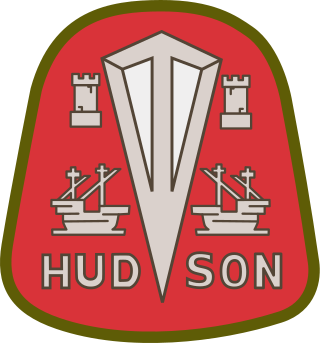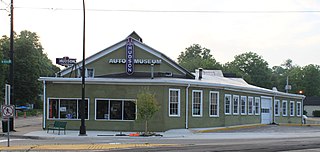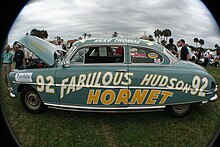
American Motors Corporation was an American automobile manufacturing company formed by the merger of Nash-Kelvinator Corporation and Hudson Motor Car Company on May 1, 1954. At the time, it was the largest corporate merger in U.S. history.

The Hudson Motor Car Company made Hudson and other branded automobiles in Detroit, Michigan, U.S., from 1909 until 1954. In 1954, Hudson merged with Nash-Kelvinator to form American Motors Corporation (AMC). The Hudson name was continued through the 1957 model year, after which it was discontinued.

The AMC Hornet is a compact automobile manufactured and marketed by American Motors Corporation (AMC) and made from 1970 through 1977—in two- and four-door sedan, station wagon, and hatchback coupe configurations. The Hornet replaced the compact Rambler American line, marking the end of the Rambler marque in the American and Canadian markets.

Marshall Pleasant Teague was an American race car driver nicknamed by NASCAR fans as the "King of the Beach" for his performances at the Daytona Beach Road Course.

Herbert Watson Thomas was a stock car racer who was one of NASCAR's most successful drivers in the 1950s. Thomas was NASCAR's first multi-time Cup Champion.

The Nash Ambassador is a luxury automobile that was produced by Nash Motors from 1927 until 1957. For the first five years it was a top trim level, then from 1932 on a standalone model. Ambassadors were lavishly equipped and beautifully constructed, earning them the nickname "the Kenosha Duesenberg".

The Nash Rambler is a North American automobile that was produced by the Nash Motors division of Nash-Kelvinator Corporation from 1950 until 1954 in sedan, wagon, and fixed-profile convertible body styles.

The Daytona Beach and Road Course was a motorsport race track that was instrumental in the formation of the National Association for Stock Car Auto Racing. It originally became famous as the location where 15 world land speed records were set.

The Hudson Hornet is a full-size car manufactured by Hudson Motor Car Company of Detroit, Michigan from 1951 until 1954, when Nash-Kelvinator and Hudson merged to form American Motors Corporation (AMC). Hudson automobiles continued to be marketed under the Hudson brand name through the 1957 model year.

The Hudson Jet is a compact automobile produced by the Hudson Motor Car Company of Detroit, Michigan, during the 1953 and 1954 model years. The Jet was the automaker's response to the popular Nash Rambler. The costs of developing and marketing the Jet ultimately led to Hudson's merger with Nash.

Abraham Edward Barit was an American industrialist who served as the president and CEO of the Hudson Motor Car Company from 1936 to 1954 when Hudson merged with Nash Motors to form American Motors Corporation (AMC). Barit served on the board of AMC following the merger of the two automakers.

Doc Hudson is an anthropomorphic 1951 Hudson Hornet who appears in the 2006 Pixar film Cars. In the film, Doc is the medical doctor and local judge for Radiator Springs. After meeting the rookie racecar Lightning McQueen, Doc reveals that he is actually a former Piston Cup racer known as the Fabulous Hudson Hornet, and returns to the Piston Cup to act as Lightning's crew chief in his races. It is implied that Doc died prior before the events of Cars 2, and he appears in flashback sequences in Cars 3.

The Ypsilanti Automotive Heritage Museum in Ypsilanti, Michigan is an automotive museum that features cars assembled at the nearby Willow Run Plant and vehicles made by Hudson Motors. The museum is an official site of the MotorCities National Heritage Area, which is "dedicated to preserving, interpreting and promoting the automotive and labor heritage of the State of Michigan."
The 1952 NASCAR Grand National Series was the fourth season of the premier stock car racing championship sanctioned by NASCAR. Once the season was concluded, driver Tim Flock was crowned the Grand National champion after winning 8 of the 33 events that he competed in. This was the first year that NASCAR scheduled its events to avoid the conflicts of having two races, at two different tracks, on the same day. The only exception was on June 1, when races were held at both Toledo Speedway in Ohio, and Hayloft Speedway in Augusta, Georgia. Herb Thomas finished second to Flock after competing in 32 races, and Lee Petty finished third in the standings that year. Throughout the 1952 season, a total of 261 drivers entered at least one of the 34 events. Virtually every American car manufacturer had at least one of their cars start that season.

The 1955 Wilkes County 160 was a NASCAR Grand National Series event that was held on April 3, 1955, at North Wilkesboro Speedway in North Wilkesboro, North Carolina.

The 1952 Wilkes County 200 was a NASCAR Grand National Series event that was held on March 30, 1952, at North Wilkesboro Speedway in North Wilkesboro, North Carolina.

The USAC Stock Car division was the stock car racing class sanctioned by the United States Auto Club (USAC). The division raced nationally; drivers from USAC's open wheel classes like Indy cars, Silver Crown, sprints, and midgets frequently competed in races and won championships. Several NASCAR drivers raced in USAC Stock Cars at various points in their careers.

The 1953 Wilkes 160 was a NASCAR Grand National Series event that was held on October 11, 1953, at North Wilkesboro Speedway in North Wilkesboro, North Carolina.

The 1958 Wilkes 160 was a NASCAR Grand National Series event that was held on October 19, 1958, at North Wilkesboro Speedway in North Wilkesboro, North Carolina.
Palm Beach Speedway was a motor sports racing venue located in West Palm Beach, Florida. The speedway hosted a total of 7 NASCAR races between January 20, 1952 and December 11, 1956. Dick Rathman had the most poles at 3, and Herb Thomas captured the most wins with 4. The half mile dirt oval was built in 1949, paved in 1955 and torn down in 1984.


















